I'm attempting to plot a stacked barplot with ggplot2 with this code
barplot <- ggplot() + geom_bar(aes(y = percentage, x = TBD, fill = TBD), data = charts.data, stat="identity")
I want to create a barplot for my single cell analysis that has 2 conditions, a treated and an untreated condition. I want to show with the barplot, the percentage of different cell types per condition to see whether the treated with having an effect on the different cell types.
How do I go about determining the percent of each cell type in each condition and then go about plotting the barplot?
output of dput(head(comparison))
structure(c(6051L, 1892L, 1133L, 893L, 148L, 868L, 5331L, 3757L,
1802L, 1061L, 2786L, 704L), .Dim = c(6L, 2L), .Dimnames = structure(list(c("Fibroblast", "T cell", "Macrophage", "Stellate", "Acinar", "Endothelial"), c("treated", "untreated")), .Names = c("",
"")), class = "table")
output of dput(head(cell_cycle_data))
structure(list(orig.ident = c("treated", "treated", "treated",
"treated", "treated", "treated"), nCount_RNA = c(1892, 307, 1348,
3699, 4205, 4468), nFeature_RNA = c(960L, 243L, 765L, 1612L,
1341L, 1644L), percent.mt = c(0.211416490486258, 1.62866449511401,
4.45103857566766, 4.4065963773993, 0.0713436385255648, 3.87197851387645
), RNA_snn_res.0.5 = structure(c(11L, 11L, 5L, 6L, 11L, 13L), .Label = c("0", "1", "2", "3", "4", "5", "6", "7", "8", "9", "10", "11", "12",
"13", "14", "15", "16", "17", "18", "19"), class = "factor"), seurat_clusters = structure(c(11L, 11L, 5L, 6L, 11L, 13L), .Label = c("0", "1", "2", "3", "4", "5", "6", "7", "8", "9", "10", "11", "12", "13", "14", "15", "16", "17", "18", "19"), class = "factor"), S.Score = c(0.476893835992198, -0.0200784617568548, -0.0335915198305002, -0.0247184276246385, 0.010785196602457, 0.0190008903712199), G2M.Score = c(0.204441469200986, 0.173804859670862, -0.0313235510969097, -0.0376796363661889, -0.0559526905696905, -0.0122031631356698), Phase = structure(c(3L, 2L, 1L, 1L, 3L, 3L), .Label = c("G1", "G2M", "S"), class = "factor"), old.ident = structure(c(7L,7L, 1L, 4L, 7L, 9L), .Label = c("Fibroblast", "T cell", "Macrophage", "Stellate", "Acinar", "Endothelial", "Tumor", "B cell", "Mast cell", "Ductal", "Islets of Langerhans"), class = "factor")), row.names = c("treated_AAACGCTAGCGGGTTA-1", "treated_AAAGGTAAGTACAGAT-1", "treated_AAAGTGAGTTTGATCG-1", "treated_AAATGGACAAAGTGTA-1",
"treated_AACAAAGGTCGACTTA-1", "treated_AACAGGGTCCTAGCCT-1"), class = "data.frame")
output of dput(tail(comparison))
structure(list(orig.ident = c("untreated", "untreated", "untreated",
"untreated", "untreated", "untreated"), nCount_RNA = c(901, 823,
1184, 1835, 1147, 1407), nFeature_RNA = c(482L, 479L, 649L, 1043L,
604L, 709L), percent.mt = c(1.77580466148724, 2.91616038882138,
4.22297297297297, 3.86920980926431, 2.0052310374891, 4.05117270788913
), RNA_snn_res.0.5 = structure(c(7L, 7L, 7L, 14L, 7L, 7L), .Label = c("0",
"1", "2", "3", "4", "5", "6", "7", "8", "9", "10", "11", "12",
"13", "14", "15", "16", "17", "18", "19"), class = "factor"),
seurat_clusters = structure(c(7L, 7L, 7L, 14L, 7L, 7L), .Label = c("0",
"1", "2", "3", "4", "5", "6", "7", "8", "9", "10", "11",
"12", "13", "14", "15", "16", "17", "18", "19"), class = "factor"),
S.Score = c(-0.0320858200243315, 0.0304725660342869, 0.0215996091745327,
0.0384166213301423, 0.144956251122548, -0.0242770509986111
), G2M.Score = c(0.0904224391544142, 0.050148242050667, -0.0178041670730754,
-0.0112596867977946, -0.0519554524339088, -0.0136533184257381
), Phase = structure(c(2L, 2L, 3L, 3L, 3L, 1L), .Label = c("G1",
"G2M", "S"), class = "factor"), old.ident = structure(c(5L,
5L, 5L, 5L, 5L, 5L), .Label = c("Fibroblast", "T cell", "Macrophage",
"Stellate", "Acinar", "Endothelial", "Tumor", "B cell", "Mast cell",
"Ductal", "Islets of Langerhans"), class = "factor")), row.names = c("untreated_TTTGGTTGTCTAATCG-18",
"untreated_TTTGGTTTCCCGAGGT-18", "untreated_TTTGTTGAGAACTGAT-18",
"untreated_TTTGTTGAGCTCGGCT-18", "untreated_TTTGTTGAGTGCCTCG-18",
"untreated_TTTGTTGCACGGTGCT-18"), class = "data.frame")

